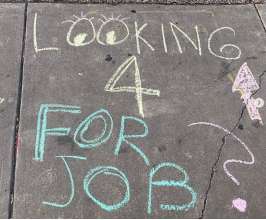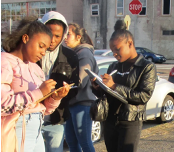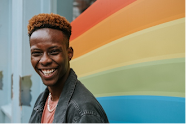 |
| Source: Fab Youth Philly |
By Sam Piha
When asked, older youth cite they are most interested in opportunities to gain work experience that is meaningful, making the real world a better place, and that can translate into their ability to earn their own money. Fab Youth Philly (FYP) is a Philadelphia-based youth development organization that provides innovative, award-winning programming for youth, with a programmatic focus on workforce development opportunities for teens ages 15-19. Below we interview Rebecca Fabiano, Founder and ED of Fab Youth Philly about their program offerings that promote youth employment and workforce development.
 |
| Source: Fab Youth Philly |
Q: FAB Youth Philly has emphasized the importance of engaging youth in work through your summer program and school year offerings. Why is this?
A: We have emphasized the importance of engaging youth in work/employment during the summer for several reasons. First, the summer presents an opportunity for deeper and extended engagement with teens. We can see them five days a week for 5-8 weeks, which allows us to build and deepen our relationships with them, and for them to build and deepen relationships with their peers, other stakeholders (partner organizations, community members, etc.). That can be up to 200-250 hours of time to support teens developmental needs, including establishing financial independence, exploring their passions and interests, and building social capital & professional networks. We know that people who are employed in their teens are more employable as an adult and have greater lifetime earnings than those that do not.
Q: Many of your program offerings engage youth in work that serves their community. Why is this important?
A: Our work is guided by three youth development principles:
- Positive relationships;
- Clear, fair and high expectations;
- Opportunities for teens to connect, navigate and be productive.
We are also keenly aware of teens developmental needs and with these things in mind, we know that teens need and want the opportunity to give back to their community.
For our Play Captain, Safety Captain and our new Lifeguard Training Certificate, the teens often talk about what drew them to these opportunities was to be of service to their community. They talk with pride as a Play Captain about their work “decreasing summer slide and helping children to return to school prepared to learn”; as a Safety Captain, they talk about “a desire to solve problems in their community”, and our new Lifeguard trainees, talk about wanting to “help open pools in their neighborhood so kids have a fun place to go in the summer”.
“Many of our Play Captains report that they enjoy being a Play Captain because they can help children reduce the summer learning slide from the games and activities they play and facilitate.” – Rebecca Fabiano
Q: Can you describe each of your youth employment program components?
A: Work Permits for Teens: In many cities, teens need a “work permit” or “working paper”. Our staff has been trained to provide that permit to youth in Philadelphia. It is considered one of the (MANY) vital documents they need to be able to work.
 |
| Source: Play Captain Initiative |
Play Captain Initiative: Every summer, Fab Youth Philly implements our award-winning Play Captain Initiative (PCI): a workforce development and civic engagement initiative with the mission to empower and train teens in leadership, playful learning and facilitation to make Playstreets, playgrounds and neighborhoods in Philadelphia more playful. Each year we get up to 200 applications and we are able to hire about 50 teens. Those teens facilitate over 70 hours of playful learning activities. During the spring and fall, our Play Captains facilitate activities at neighborhood parks and playgrounds, providing an opportunity to continue working throughout the year.
“For more than 85% of our teens, this is their first job experience; and we take that very seriously. We build in from application to exit survey opportunities for them to experience and practice things they may encounter again with future employers.” – Rebecca Fabiano
 |
| Source: Fab Youth Philly |
Safety Captain Initiative: Teens are paid to use a project-based-learning approach to answer questions like: What makes a neighborhood youth-friendly? What makes a neighborhood safe for teens? They conduct research, complete community asset mapping, go on field trips and have guest speakers. Upon completion of the 12-week program, they present their findings to the public.
 |
| Source: Fab Youth Philly |
Little Library Stewards: In November 2022, we launched a new initiative called the Little Library Stewards (LLS). LLS creates a job for teens and helps a community asset from becoming a community nuisance. Many little libraries, where you can take a book and/or leave a book in a former newspaper box, are cared for by a resident or are left without a caretaker. As a Steward, teens are responsible for maintaining, cleaning, and stocking little libraries. We have piloted this initiative with some of our older teens, though in the fall, we are looking to make this opportunity available to 14-year-olds (the youngest age a teen can legally work in Pennsylvania), as way for them practice and develop various workplace “muscles,” such as punctuality, communication, attendance, and workplace technology.
Youth Advisory Board: In December 2022, we launched our Youth Advisory Board with eight teens, who have been part of previous FYP programming. Being on the Youth Advisory Board is a paid position and members meet weekly between the months of September and May. The Youth Advisory Board is tasked with planning events, reviewing Play Captain & Little Library training, supporting participant recruitment and outreach. They are learning about budgeting, planning and decision making. We plan to keep these numbers relatively low, employing up to 10 teens per year.
 |
| Source: Fab Youth Philly |
Lifeguard Certification Training: One of our newest initiatives is our Lifeguard Certificate Training program in collaboration with Philadelphia Parks & Recreation (PPR). We had 248 applicants for 15 slots. Every summer PPR needs to hire nearly 300 lifeguards to be able to open all of the public pools, but falls short every year, leaving some pools closed in the neediest neighborhoods. With this in mind and knowing that teens are looking to establish financial independence, we have established a partnership that capitalizes on each organization's assets. Drexel University is providing the pool, PPR is providing the Water Safety Instructors, and we have raised funds with our partner Drexel’s West Philadelphia Promise Neighborhood to pay teens and to outfit each of them with a bathing cap, goggles, bathing suits, towel, and flip flops. The teens participate in weekly workshops about how to create a resume and a cover letter, as well as how to apply for and interview for lifeguard positions.
Our plan in the fall is to pay teens $10 to learn how to swim (thereby increasing the number of young people who have this important life skill, possibly decreasing water safety issues at public pools); then, for those who want to, they can test into the Lifeguard Certification program at $12 hour, and then be hired by PPR at $16 in the summer. Teens learning to swim will go on field trips and have guest speakers to help connect them to the rich history of public pools and swimming and to help develop their identity as a swimmer, while the teens in the Lifeguard Training program will continue to get workforce development workshops.
Q: For many youth participants who obtain first time jobs, do you offer any financial literacy info on how to handle their money?
A: Yes. We provide a workshop on How to Read Your First Paycheck, one on creating a budget and in January, we invite them back for a workshop called I Got My W2, Now What Do I Do? so they learn about filing taxes.
Q: How can programs learn more about replicating one of these components and does your organization offer any staff trainings or coaching for youth programs outside of Philadelphia?
A: We LOVE to visit other cities and conduct trainings on a WIDE range of topics pertaining to workforce development, youth development, trauma-informed youth development practices, and effective facilitation. For more information you can contact me at rebecca@fabyouthphilly.com.
MORE ABOUT...
For nearly 25 years,
Rebecca Fabiano (She/Her) has worked in various capacities across nonprofit and youth-serving organizations, served on boards and helped to build solid youth programs that engage, encourage, and create spaces for positive development. As a program leader, she has successfully raised funds and managed program budgets; hired and supervised staff; developed and sustained strong community partnerships and designed award-winning programming.
To learn more from Rebecca on the topic of program strategies to promote youth employment and workforce development, join us for this webinar:
Other resources you may find useful:





























